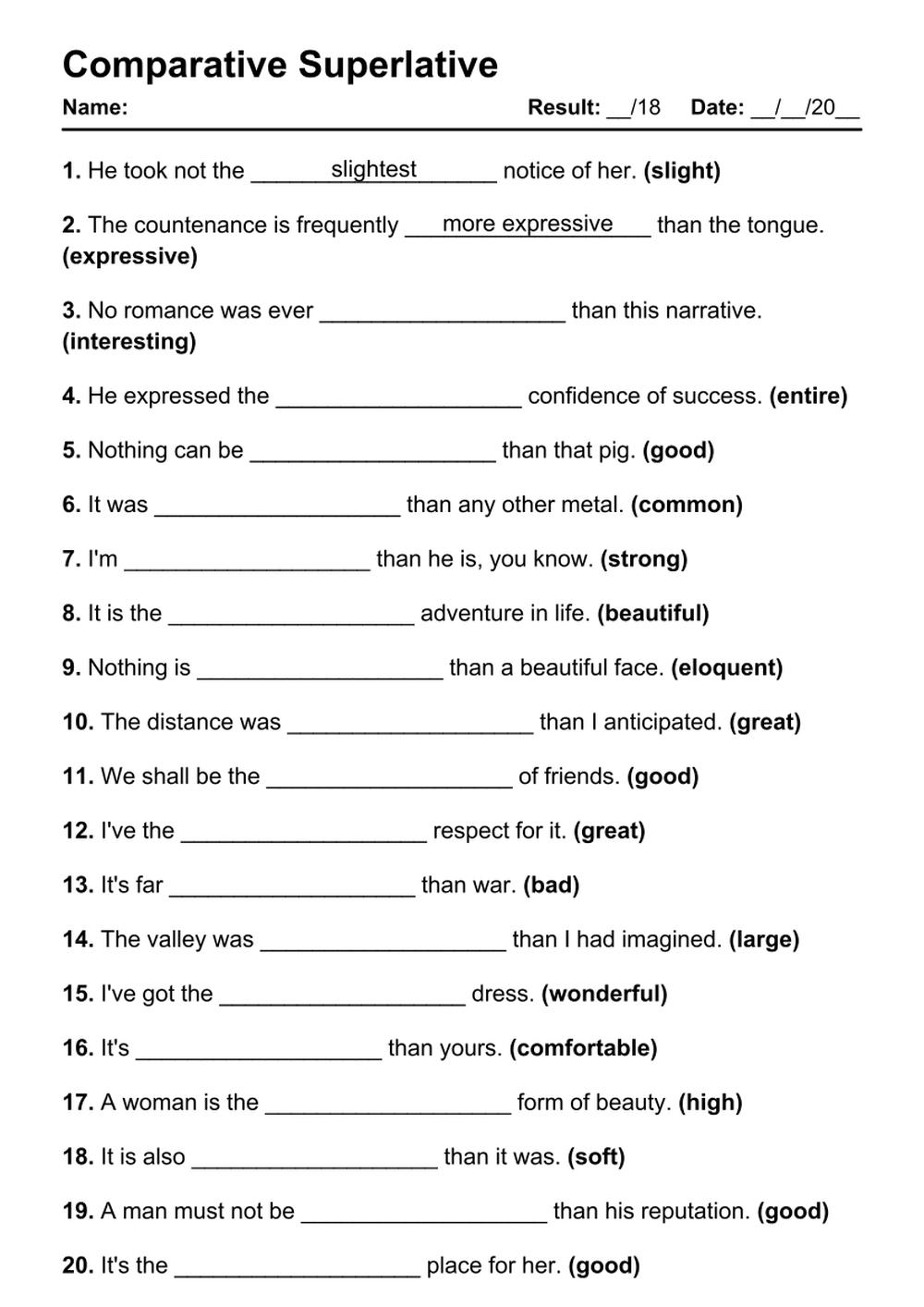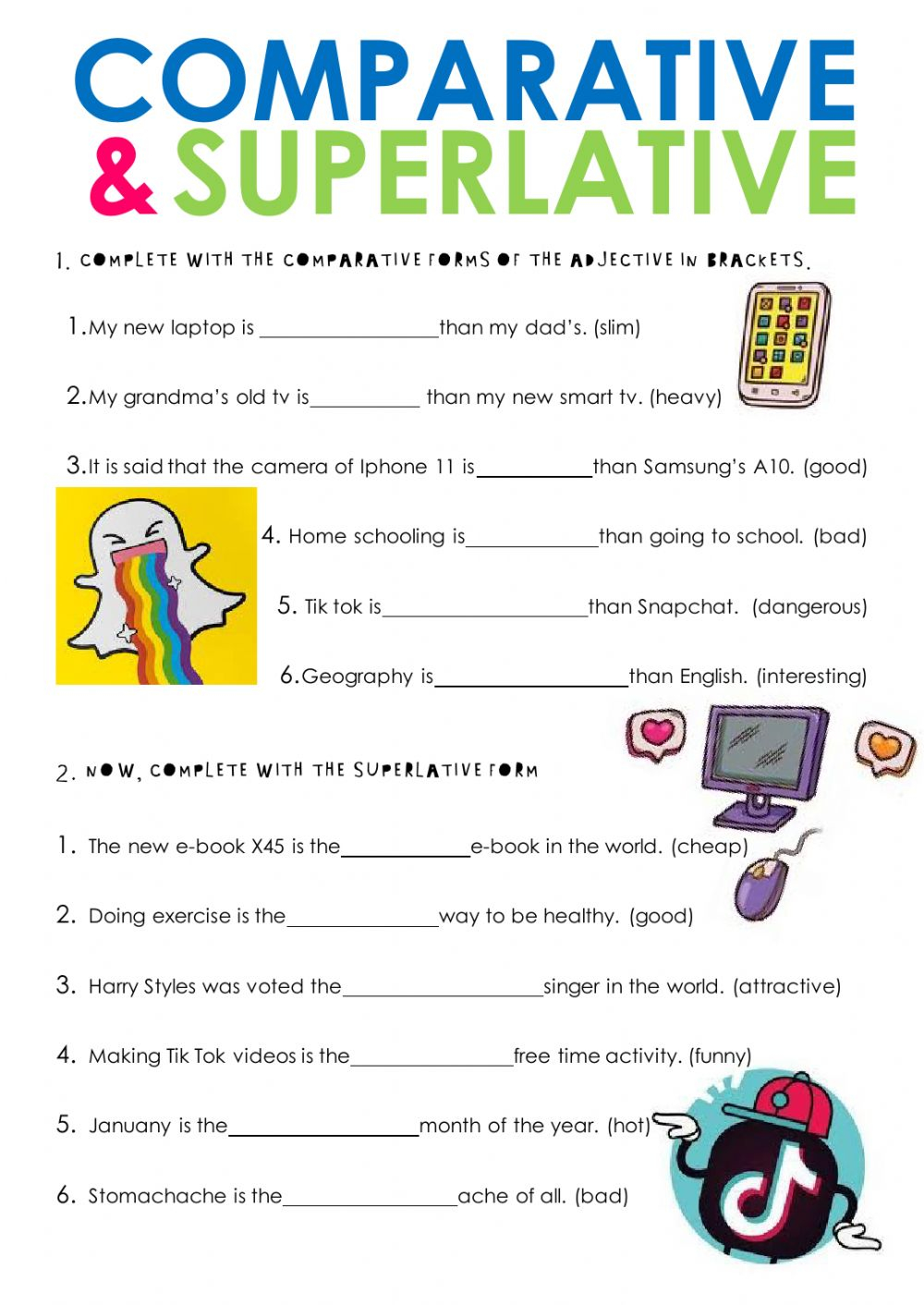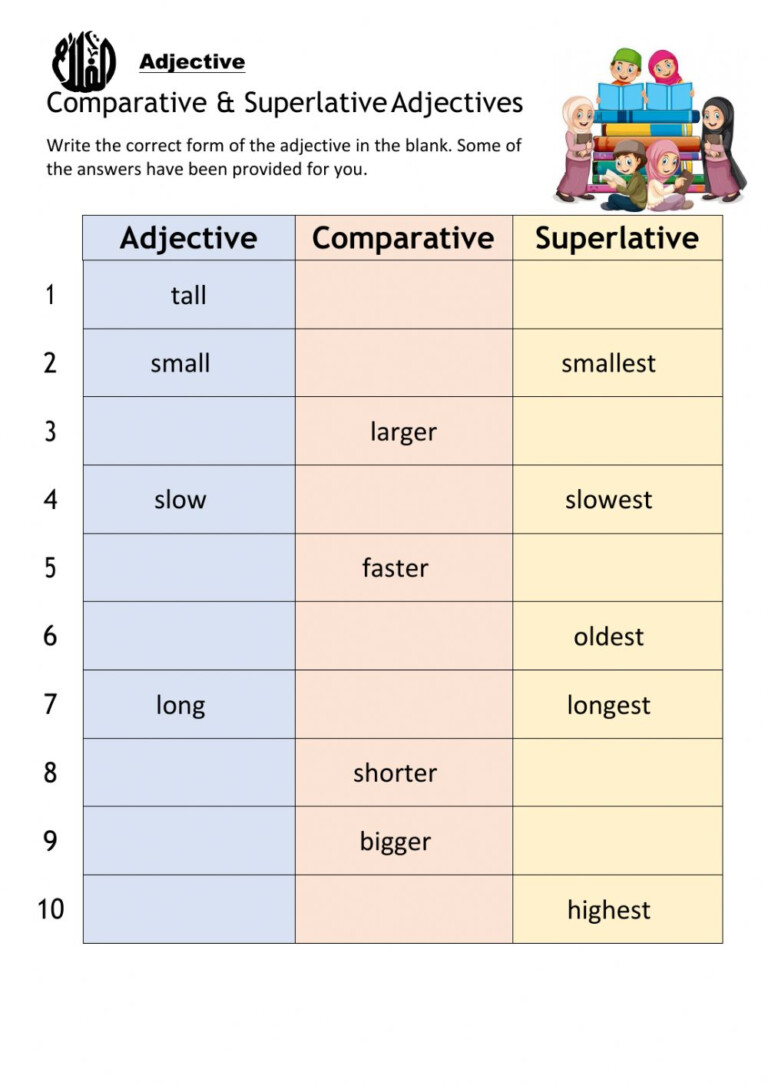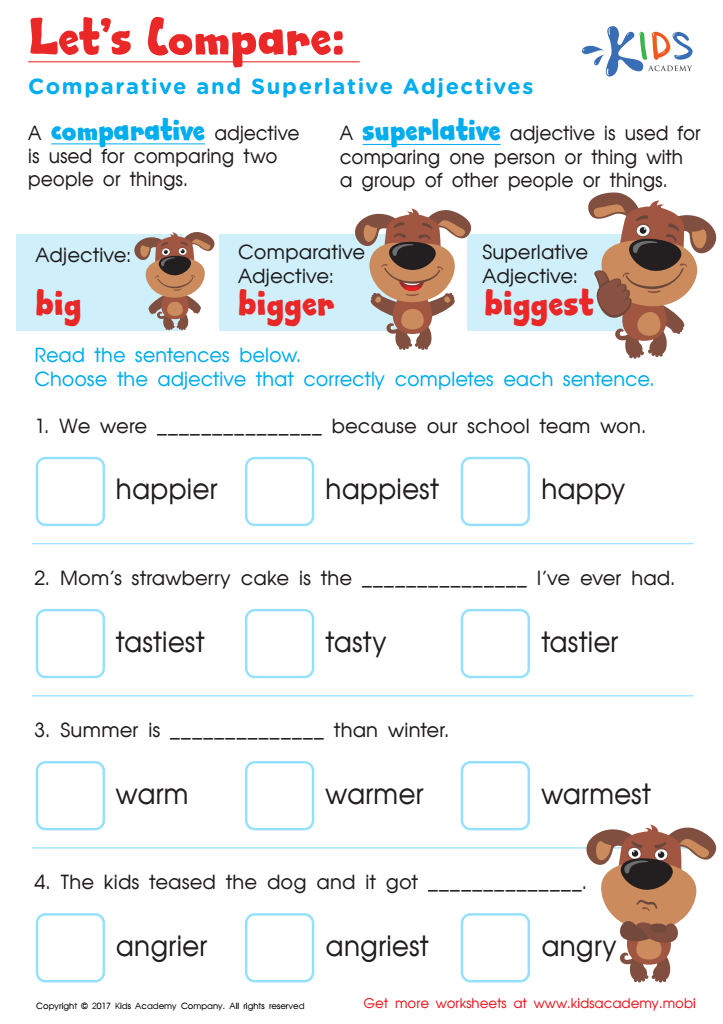
Mastering Comparisons: The Indispensable Role of Comparative and Superlative for ELL Worksheets
English proficiency is a cornerstone for academic success, professional advancement, and effective social interaction in an increasingly globalized world. For English Language Learners (ELLs), navigating the complexities of English grammar can be a daunting, yet crucial, journey. Among the many grammatical structures that present challenges, comparative and superlative adjectives and adverbs often stand out. These structures are vital for expressing nuanced ideas, making comparisons, and describing the world with precision. To effectively equip ELLs with these skills, educators frequently turn to targeted, well-designed materials. This article delves into the profound utility of comparative and superlative for ELL worksheets, exploring their importance, design principles, various applications, and how they contribute to a comprehensive language acquisition strategy.
Understanding the Fundamentals: Comparatives and Superlatives
Before delving into the worksheets themselves, it’s essential to briefly revisit the core concepts.

Comparative Adjectives and Adverbs: These are used to compare two things, people, or actions.

- Adjectives: They describe nouns. When comparing two nouns, we use a comparative adjective followed by "than."

- Examples: "taller than," "more beautiful than," "faster than."
- Rules:
- For most one-syllable adjectives, add "-er" (e.g., "tall" -> "taller").
- For adjectives ending in ‘y’, change ‘y’ to ‘i’ and add "-er" (e.g., "happy" -> "happier").
- For most two-syllable adjectives ending in ‘-er’, ‘-le’, ‘-ow’, add "-er" (e.g., "narrow" -> "narrower").
- For adjectives with two or more syllables, use "more" before the adjective (e.g., "expensive" -> "more expensive").
- Irregulars: "good" -> "better," "bad" -> "worse," "far" -> "farther/further."




- Adverbs: They describe verbs, adjectives, or other adverbs.

- Examples: "runs faster than," "more slowly than," "works harder than."
- Rules:
- For most one-syllable adverbs, add "-er" (e.g., "fast" -> "faster").
- For adverbs ending in ‘-ly’, use "more" before the adverb (e.g., "quietly" -> "more quietly").
- Irregulars: "well" -> "better," "badly" -> "worse."

Superlative Adjectives and Adverbs: These are used to compare three or more things, people, or actions, indicating which one is at the extreme end of a quality.
- Adjectives: They describe nouns. We use "the" before the superlative adjective.
- Examples: "the tallest," "the most beautiful," "the fastest."
- Rules:
- For most one-syllable adjectives, add "-est" (e.g., "tall" -> "tallest").
- For adjectives ending in ‘y’, change ‘y’ to ‘i’ and add "-est" (e.g., "happy" -> "happiest").
- For most two-syllable adjectives ending in ‘-er’, ‘-le’, ‘-ow’, add "-est" (e.g., "narrow" -> "narrowest").
- For adjectives with two or more syllables, use "most" before the adjective (e.g., "expensive" -> "most expensive").
- Irregulars: "good" -> "best," "bad" -> "worst," "far" -> "farthest/furthest."
- Adverbs: They describe verbs, adjectives, or other adverbs. We use "the" before the superlative adverb.
- Examples: "runs the fastest," "the most slowly," "works the hardest."
- Rules:
- For most one-syllable adverbs, add "-est" (e.g., "fast" -> "fastest").
- For adverbs ending in ‘-ly’, use "most" before the adverb (e.g., "quietly" -> "most quietly").
- Irregulars: "well" -> "best," "badly" -> "worst."
The Unique Challenges for ELLs
While the rules seem straightforward, ELLs face several hurdles when mastering comparatives and superlatives:
- First Language Interference (L1): Many languages do not have a direct equivalent to English’s comparative and superlative structures, or they form them very differently. This can lead to direct translation errors (e.g., "more tall" instead of "taller").
- Rule Memorization and Application: The various rules (adding -er/-est, using "more/most," spelling changes, irregular forms) require significant memorization and practice to apply automatically.
- Distinguishing Adjectives and Adverbs: Understanding when to modify a noun (adjective) versus a verb/adjective/adverb (adverb) can be confusing, especially with words that can function as both (e.g., "fast").
- Usage of "Than" and "The": Omitting "than" in comparative sentences or "the" in superlative sentences is a common error.
- Pronunciation and Spelling: Adding suffixes like "-er," "-est" can sometimes affect the base word’s spelling (e.g., "big" -> "bigger," "biggest"; "hot" -> "hotter," "hottest"), requiring attention to detail.
- Nuance and Context: Understanding when to use a comparative versus a superlative, and the subtle differences in meaning (e.g., "older" vs. "elder"), comes with exposure and practice.
Why Comparative and Superlative for ELL Worksheets are Indispensable
The strategic incorporation of comparative and superlative for ELL worksheets provides a structured and repeatable framework that directly addresses these challenges. Here’s why they are so valuable:
- Structured Practice: Worksheets offer controlled environments for practicing new grammatical structures. They break down complex rules into manageable chunks, allowing learners to focus on one aspect at a time.
- Reinforcement and Repetition: Mastery in language acquisition comes through repeated exposure and practice. Worksheets provide ample opportunities for this, solidifying understanding and promoting automaticity.
- Self-Paced Learning: ELLs learn at different rates. Worksheets allow students to work at their own pace, reviewing concepts as needed without feeling rushed or holding back the class.
- Visual and Kinesthetic Learning: Many worksheets incorporate visuals (pictures, diagrams) and require physical interaction (writing, circling, matching), catering to diverse learning styles.
- Targeted Skill Development: Unlike general conversation, worksheets can isolate specific grammar points, ensuring that the learner’s attention is focused solely on comparatives and superlatives.
- Formative Assessment Tool: Worksheets serve as excellent tools for educators to quickly gauge student comprehension, identify common errors, and tailor future instruction.
- Building Confidence: Successfully completing a worksheet provides a sense of accomplishment, boosting confidence and motivating ELLs to tackle more complex tasks.
- Homework and Review: Worksheets are ideal for assigning homework, allowing students to review concepts outside the classroom and reinforcing what they’ve learned.
Key Features of Effective Comparative and Superlative for ELL Worksheets
Not all worksheets are created equal. Effective comparative and superlative for ELL worksheets share several key characteristics:
- Clear and Concise Instructions: ELLs benefit from simple, unambiguous instructions, possibly with examples.
- Gradual Increase in Difficulty (Scaffolding): Start with basic identification and simple transformations before moving to more complex sentence construction or contextual usage.
- Example: Start with "tall -> taller -> tallest" then move to "My brother is ____ (tall) than me."
- Contextualization: Grammar should not be taught in isolation. Worksheets that present comparisons within meaningful contexts (e.g., comparing family members, animals, cities) make the learning more relevant and memorable.
- Visual Aids: Pictures, graphs, and charts can significantly enhance understanding, especially for lower-level ELLs, by providing non-linguistic cues.
- Relevant Vocabulary: Use vocabulary that is familiar or easily decipherable, so the focus remains on the grammar point rather than new words.
- Variety of Exercise Types: Mix and match different formats to keep engagement high and address various learning preferences.
- Error Identification and Correction: Include exercises where students identify and correct common errors, which is a higher-order thinking skill.
- Answer Keys (for self-correction): Providing answer keys empowers students to check their own work, learn from mistakes, and develop autonomy.
Types of Comparative and Superlative for ELL Worksheets Activities
From basic fill-in-the-blanks to more complex error correction exercises, the variety offered by comparative and superlative for ELL worksheets can cater to different learning styles and proficiency levels.
- Fill-in-the-Blanks:
- Format: Sentences with blanks where students must insert the correct comparative or superlative form of a given adjective/adverb.
- Example: "The elephant is (big) than the mouse." / "Mount Everest is the (high) mountain in the world."
- Sentence Transformation:
- Format: Students rewrite sentences using comparative or superlative forms.
- Example: "The red car is fast. The blue car is faster. (Combine using comparative)" / "New York is a big city. London is a big city. Tokyo is the biggest city. (Rewrite using superlatives)."
- Picture-Based Comparisons:
- Format: Worksheets display pictures of objects, people, or animals for students to compare using comparative/superlative forms.
- Example: Pictures of three animals (a rabbit, a dog, an elephant) and prompts like "The rabbit is (small) than the dog." "The elephant is the (large) animal."
- Comparison Charts/Tables:
- Format: Students complete tables comparing attributes of different items (e.g., comparing two cities by population, size, cost of living) and then write sentences based on the data.
- Example: A table comparing apples and bananas by weight, price, and sweetness, followed by prompts to write sentences like "Apples are ____ (sweet) than bananas."
- Error Correction:
- Format: Students identify and correct grammatical errors related to comparatives and superlatives in given sentences.
- Example: "She is more taller than her sister." (Correction: "She is taller than her sister.") / "He is the most fast runner." (Correction: "He is the fastest runner.")
- Adjective/Adverb Transformation Drills:
- Format: A simple list of base adjectives/adverbs for students to convert into their comparative and superlative forms.
- Example: "Good -> -> " / "Beautiful -> -> "
- Creative Writing Prompts:
- Format: Students use comparatives and superlatives to write short paragraphs, descriptions, or stories.
- Example: "Describe your family members using comparative and superlative adjectives." / "Write about your dream vacation and compare it to other places you’ve visited."
Integrating Worksheets into a Comprehensive ELL Curriculum
While worksheets are powerful, they are most effective when integrated into a holistic language learning approach.
- Pre-teaching and Modeling: Before assigning a worksheet, explicitly teach the rules, provide clear examples, and model how to complete the exercises.
- Speaking Practice: Follow up worksheet activities with oral practice. Have students read their completed sentences aloud, compare things in the classroom, or engage in debates using comparative and superlative forms.
- Listening Comprehension: Use audio clips or teacher-led descriptions that prominently feature comparative and superlative forms, asking students to identify or answer questions based on the comparisons.
- Reading Activities: Provide authentic texts (articles, stories) where comparatives and superlatives are naturally used. Ask students to identify these forms and discuss their meaning in context.
- Games and Interactive Activities: Turn worksheet content into games like "comparison bingo," "adjective charades," or "superlative scavenger hunts" to make learning fun and dynamic.
- Real-World Application: Encourage students to notice and use comparatives and superlatives in their daily lives, whether comparing prices at a store, describing friends, or talking about sports teams.
Tips for Educators Using Worksheets
- Differentiate: Provide different levels of worksheets for students with varying proficiency levels. Some might need more scaffolding, while others are ready for more complex tasks.
- Provide Timely Feedback: Review worksheets promptly and provide constructive feedback. Focus on understanding errors rather than just marking them wrong.
- Encourage Self-Correction: When students make mistakes, guide them to identify and correct their own errors rather than simply giving them the answer.
- Make it Fun: Incorporate engaging themes, colorful designs, and a variety of exercise types to keep students motivated.
- Don’t Overuse: While beneficial, relying solely on worksheets can lead to boredom and a lack of authentic language use. Balance them with communicative activities.
Conclusion
The journey of English language acquisition for ELLs is multifaceted, requiring a blend of explicit instruction, meaningful practice, and real-world application. Within this journey, mastering comparative and superlative forms is a critical step towards achieving fluency and expressing complex ideas. Comparative and superlative for ELL worksheets serve as an invaluable resource, providing the structured, repeatable, and targeted practice necessary to overcome common grammatical hurdles. By carefully designing and strategically integrating these worksheets into a comprehensive curriculum, educators can empower ELLs to confidently compare, contrast, and describe the world around them with greater accuracy and eloquence, paving the way for enhanced communication and deeper understanding. The thoughtful creation and application of comparative and superlative for ELL worksheets will undoubtedly empower these learners to ascend to new heights in their English language proficiency.
